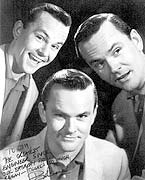Middlesex in 1919, put together a five-watt transmitter, the forerunner of KNX. He was
first granted the call letters 6ADZ, later changed to KGC, and finally to KNX. Christian began broadcasting on September 10, 1920 by playing recorded music
borrowed from music stores and technically becoming L.A.’s first disc jockey.
Bob Crane’s KNX Studio, circa 1950’s
By the Summer of 1922, about 22 other stations in and around the Los Angeles area were
broadcasting on a shared single wave length of 360 meters, but KNX was one of the only
three stations to gain success and go onto a long history of continuous operation. In 1929,
KNX increased power to 5,000 watts, then 10,000 in 1932, 25,000 watts in 1933 and finally,
50,000 watts in 1934.
In 1938, KNX moved into the new KNX/CBS Studios on Sunset Boulevard in
Hollywood which became famous as “Columbia Square”. It was here that the great CBS
Radio stars such as Eddie Cantor, Al Jolson, Jack Benny,
A composite photo of Bob Cranes, autographed “To Jim, the best engineer since our Saturday show began, Thanks so much, Bob Crane”
Gene Autry, Steve Allen, Edgar Bergen, Bing Crosby,
Orson Welles, Red Skelton, Jackie Gleason, George Burns
and Gracie Allen made history broadcasting their shows in front of a live
audience.
In the 1940’s and 50’s KNX served as a moderately successful music and personality
station featuring CBS network shows hosted by Art Linkletter and Arthur Godfrey.
But it wasn’t until Bob Crane arrived at KNX to do mornings that KNX radio
became a dominant force in the L.A. market. Other notable talents included Bill Ballance, Rege Cordic, Jim Hawthorne and Michael Jackson.
This aircheck features Bob Crane and his brilliant engineer celebrating
their 5th KNX anniversary show. It includes a hilarious interview with comedian
Jonathan Winters. Crane remained at KNX until 1965 when he departed to pursue
his acting career. His role as Col. Robert Hogan on the hit TV series Hogan’s
Heroes catapulted him to international stardom. But tragically, in the early morning
hours of June 29th, 1978, Bob Crane was murdered in his Scottsdale AZ. apartment as he
slept.



